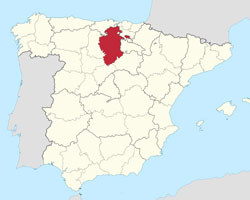Burgos in Burgos
 The province of Burgos lies in the north of Spain and is part of the autonomous region of Castilla y Leon. It borders Cantabria to the north, the Basque Country, La Rioja and the province of Soria to the east. the province of Segovia to the south and to the west the provinces of Valladolid and Palencia.
The province of Burgos lies in the north of Spain and is part of the autonomous region of Castilla y Leon. It borders Cantabria to the north, the Basque Country, La Rioja and the province of Soria to the east. the province of Segovia to the south and to the west the provinces of Valladolid and Palencia.
The province covers 14,022 m2 and in 2016 had a population of 360,995. It is the Spanish province with the highest number of municipalities, a total of 371, and three of these have a population of over 30.000.
Burgos has a host of historical monuments, the famous Camino de Santiago crosses the province and it is also the home to one of Spain’s most well-known wines with the coveted title Denominación de Origen: Ribera del Duero.
The capital city of Burgos is Burgos!
The city is home to 175,623 (2017) souls distributed on 107.06 km2. It lies dead central in the province and is surrounded by a green belt. Historically it has been the capital of the County of Castilla, the Kingdom of Castilla and the Crown of Castilla. It was in the city of Burgos that the Catholic Kings dictated las Leyes de Burgos (the Laws of Burgos) which were directed at the new colonies in the Americas, and actually constituted the basis of the present Human Rights.
Later on the city became the capital of the former province of Castilla la Vieja and it was the first provisional capital of the autonomous region of Castilla y Leon. So Burgos is definitely a capital city!
The city lies 244km north of Madrid and is situated in an area of low mountains with the height of the city varying between 827 and 997 metres above sea level. The centre of the city is at 859m. The city is divided in two by the river of Arlanzón.
Due to its high altitude the average temperatures of Burgos are about five degrees Celcius lower than those of other cities in the same area. The rainfall averages 4-600 mm a year with spring being the wettest season closely followed by autumn. The summers are hot without too much rain fall, and the winters freezing with the temperatures often dropping below -10°C.
As mentioned above, the city of Burgos has played an important role in the history of Spain over the centuries. But its importance goes back far beyond any written history.
In the valley of Arlanzón, only 15km from the present city centre, human remains have been found which are more than a million years old. Human bones found in the area, which is considered the crib of Europe, belong to three different species: Homo antecessor, Homo heidelbergensis and Homo sapiens, and scientist actually expect also to find remnants of Homo neanderthalensis in the near future!
 The city of Burgos experienced its golden age in the 16th century when the economy turned from its traditional main focus on agriculture to commerce. However, it did not last long and at the end of the century it entered a period of decay caused partly by outside influences (the most important of which was the transferral of the capital to Madrid), partly from inside events such as a succession of outbreaks of the plague which decimated the population.
The city of Burgos experienced its golden age in the 16th century when the economy turned from its traditional main focus on agriculture to commerce. However, it did not last long and at the end of the century it entered a period of decay caused partly by outside influences (the most important of which was the transferral of the capital to Madrid), partly from inside events such as a succession of outbreaks of the plague which decimated the population.
The downward trend lasted until the end of the 18th century, when a long, slow revival of the city and its economy started.
Today, Burgos’s main source of income is industry, but the service sector is gaining ground and more and more tourists, mainly from Germany and France, visit the city, which has many cultural attractions and museums, and is also well known for its gastronomical delights.
The most visited spots include the Gothic cathedral, the Museum of Human Evolution and the Castle of Burgos.
On the gastronomical side, Burgos’s traditional animal farming makes roast meats, black pudding and fresh cheese the stars of the restaurant menus.


